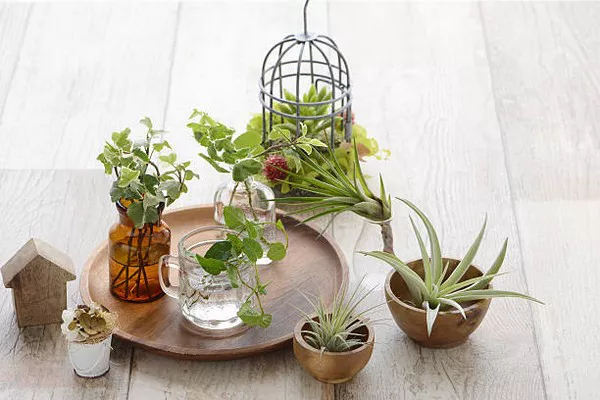Air plants, scientifically known as Tillandsia, have captivated plant enthusiasts with their unique ability to thrive without soil and minimal care requirements. Originating from diverse environments in Central and South America, these fascinating epiphytes have gained popularity as captivating indoor ornamentals. With their enchanting aesthetic appeal and low-maintenance nature, air plants have become a favorite choice for both novice and experienced plant lovers. In this guide, we will explore the essentials of caring for air plants to ensure their health, vitality, and longevity.
Understanding Air Plants
Air plants belong to the Bromeliaceae family and are renowned for their distinct growth habits. Unlike conventional plants, air plants don’t require soil for growth. Instead, they anchor themselves to other surfaces, such as trees, rocks, and even wires, using their specialized trichomes. Trichomes are hair-like structures on their leaves that enable them to absorb moisture and nutrients from the air.
Light Requirements
Proper lighting is crucial for the health of air plants. These plants thrive in bright, indirect light. Placing them near a window with filtered sunlight is ideal. However, direct sunlight can be harmful, causing their leaves to scorch. If you’re growing air plants indoors, ensure they receive sufficient light exposure. You can also use artificial light sources, such as fluorescent or LED lights, to provide the necessary illumination.
Watering Techniques
One of the most common misconceptions about air plants is that they solely rely on air for sustenance. While they don’t require soil, they do need water to survive. Regular misting is insufficient to meet their hydration needs. Instead, consider the following watering methods:
Misting: Mist your air plants with water using a spray bottle a few times a week. Ensure that the mist reaches all parts of the plant, including the base and the undersides of the leaves.
Soaking: Submerge your air plants in room-temperature water for about 20-30 minutes once a week. After soaking, gently shake off excess water and allow them to dry upside down to prevent water from accumulating at the base, which can lead to rot.
Drying: After watering, it’s crucial to allow your air plants to dry completely within 4 hours. Waterlogged plants are susceptible to rot and other diseases.
The frequency of watering depends on factors such as the humidity of your environment, the season, and the specific air plant species. Always observe your plants and adjust the watering schedule accordingly.
Humidity Considerations
Air plants naturally hail from humid environments, and maintaining appropriate humidity levels is essential for their well-being. If you live in a dry climate, consider the following methods to enhance humidity:
Misting: Regular misting not only provides moisture to the plants but also increases the humidity around them.
Humidifier: Placing a humidifier in the vicinity of your air plants can help create an environment that mimics their native habitat.
Grouping: Cluster your air plants together. As they release moisture during transpiration, they collectively increase the humidity around them.
Temperature Range
Air plants prefer moderate temperatures similar to those found in most indoor environments. They generally thrive in temperatures ranging from 50°F to 90°F (10°C to 32°C). Avoid exposing them to extreme temperature fluctuations and drafts, as these conditions can stress the plants.
Fertilization Practices
While air plants don’t require regular fertilization, providing them with nutrients can promote healthier growth and vibrant blooms. Use a diluted, balanced, water-soluble fertilizer formulated for epiphytic plants. Apply the fertilizer once a month during the growing season (spring and summer) and reduce or halt fertilization during the dormant period (fall and winter).
Mounting and Display
Air plants can be creatively displayed in various ways, enhancing both your living space and their health:
Mounting: Attach your air plants to decorative surfaces like driftwood, shells, or stones using plant-safe adhesive, fishing line, or wire. Ensure the base of the plant makes good contact with the mounting surface.
Hanging: Hang air plants in glass terrariums, geometric holders, or other hanging containers to showcase their unique beauty.
Container Gardens: Create mini gardens by arranging air plants with complementary items like pebbles, decorative sand, and other small plants.
Grooming and Maintenance
Regular maintenance ensures the longevity and attractiveness of your air plants:
Trimming: Trim dead or brown leaves using clean, sharp scissors to enhance the plant’s appearance and prevent rot.
Pup Removal: As air plants grow, they produce offsets called “pups.” These can be gently separated from the parent plant when they are about one-third of its size. Allow the pups to establish their root systems before mounting them.
Conclusion
Air plants are captivating botanical wonders that can add a touch of natural elegance to any living space. By understanding their unique growth requirements and following the guidelines outlined in this article, you can cultivate healthy and thriving air plants. Whether you’re a seasoned horticulturist or a beginner, the low-maintenance charm of air plants offers an exciting and rewarding journey into the world of indoor gardening.


